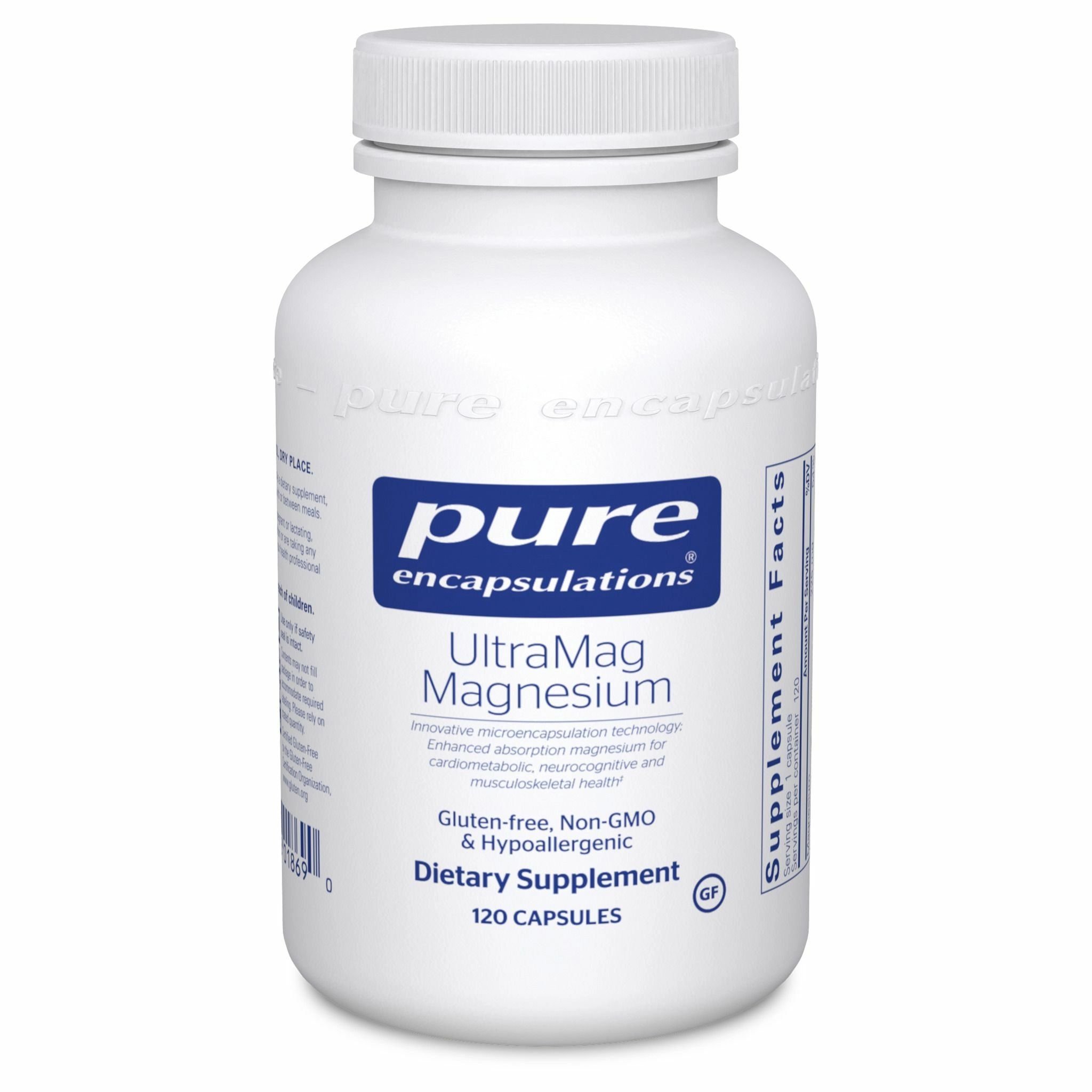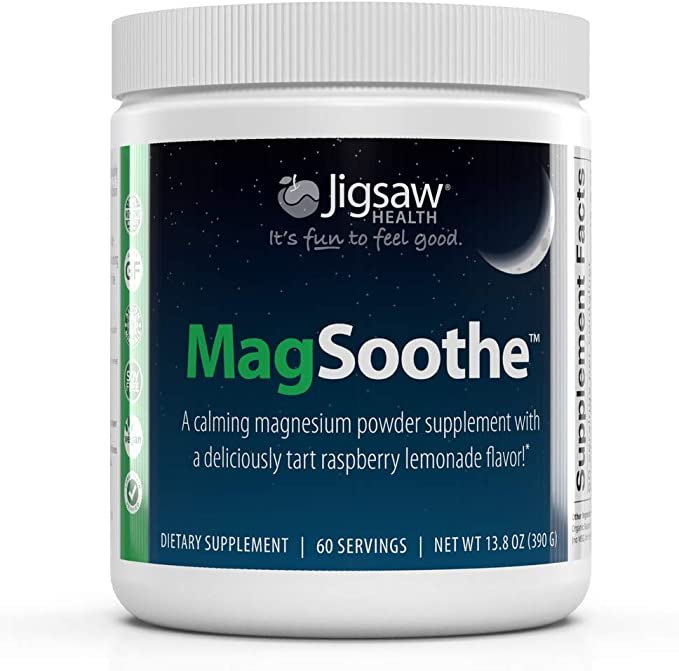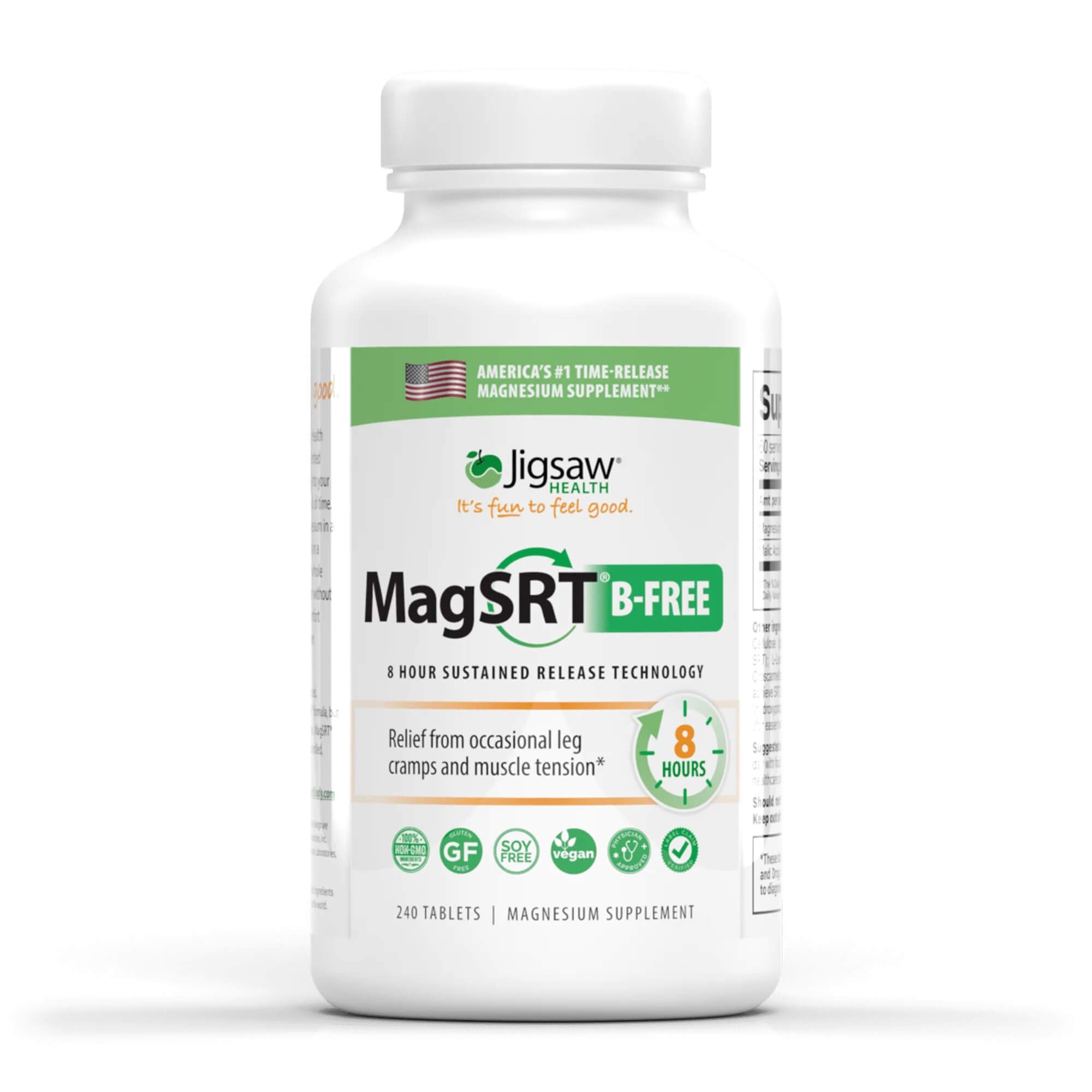Magnesium Supplements in Australia: Which Type is Best for You're Unique Needs?
Magnesium is an essential mineral for the human body, and is the second most abundant intracellular cation. It plays a critical role in almost all major metabolic and biochemical processes and serves as a cofactor in hundreds of enzymatic reactions. Maintaining adequate intake through diet is essential for not only survival but to thrive and function optimally. Most of the 21-28g of stored magnesium in our body is located in our bones, which accounts for approximately 55%. The rest is primarily found in muscles and other soft tissues.
Various studies indicate that in most countries people do not consume enough magnesium in their diet. In 2005, King et al. found that almost 60% of Americans did not consume the recommended daily amount of magnesium through their diet. Similarly, in 2015, the Dietary Guidelines Advisory Committee stated that many Americans do not consume enough magnesium as it is an under-consumed nutrient. Other countries around the world have found similar findings regarding inadequate dietary magnesium intake.
Magnesium Deficiency
Magnesium deficiency is commonly the result of reduced consumption, inadequate absorption and/or increased excretion from the body. Because magnesium is involved in so many cellular processes and enzymatic reactions sub-optimal magnesium levels or frank magnesium deficiency can manifest in a broad range of symptoms and involve most organs systems. Magnesium deficiency and inadequate intake through diet has been extensively studied with many conditions been shown to be impacted.
There are two categories of nutrient deficiencies: frank deficiencies (such as scurvy caused by a lack of ascorbic acid or goiter from a lack of iodine) and subclinical deficiencies (a reduction in physiological, cellular, and/or biochemical functions that doesn't show any obvious clinical symptoms). The latter is more worrisome as it's difficult to detect and increases the risk of chronic diseases such as vascular calcifications that can develop over time.
A particular subset of magnesium deficiency know as chronic latent magnesium deficiency (CLMD) is where individuals experience a chronic and subtle lack of magnesium that makes them more susceptible to diseases. In this condition, their serum magnesium levels are in the lower half of the reference interval, therefore appear to have “normal” test results, but they do not maintain a magnesium status sufficient for long-term vibrant health.
Whilst our current usual magnesium intake even though sufficient to avoid frank magnesium deficiency, is unlikely to be sufficient for optimal magnesium status and many functional medical professionals suggest it is likely to be associated with subclinical magnesium deficiency. According to the literature, subclinical magnesium deficiency is widespread and a major contributor to chronic diseases, such as cardiovascular disease, osteoporosis and early mortality, with many researchers urging it should be viewed as a public health crisis. Further to this because magnesium levels in our blood and cells needs to be tightly regulated thus when magnesium intake is low, the body can pull out magnesium from the bone to keep the blood level normal. This means that even if the blood (serum) level of magnesium is normal, a person may still have magnesium deficiency that can be a predisposing factor to osteoporosis, osteopenia, and fractures.
Studies of the nutrient intake in the Paleolithic diet of ancient hunter-gatherer societies indicated a magnesium intake of around 600 mg per day, which is significantly more than what is typical today, and in part explains why high normal magnesium concentrations on testing is not commonly seen in most the everyday population. For reference the daily recommended intake of magnesium for the adults is around 300–400 mg/day.
Part of the problem with inadequate magnesium intake & magnesium deficiency in society today is to do with modern farming practices, lack of minerals due to soil erosion and overall decreased magnesium content in food. Wheat alone has dropped just shy of 20% since 1968 which scientists have suggested to do with more acidic soil and unbalanced use fertilisers with high nitrogen, phosphorus and potassium levels at the expense of magnesium. In the UK since the 1940s there has been loss of magnesium in beef (−4 to −8%), bacon (−18%), chicken (−4%), cheddar cheese (−38%), parmesan cheese (−70%), whole milk (−21%) and vegetables (−24%).
Other factors that can contribute to magnesium deficiency include dietary aluminum intake which may reduce the absorption of magnesium by approximately fivefold. Something to consider seriously and some basic guidelines include avoid using aluminum cookware, cut out any aluminum lined cans or food containers & choose aluminum free deodorants such as Pit-Stop. Excessive calcium supplementation also needs to be considered as calcium will compete with magnesium for absorption, and vitamin D over-supplementation needs to be cautioned as this can cause severe magnesium deficiency. There is speculation that fluoride, which can be found easily in the environment, and often added to scheme water, can react with magnesium and create sellaite or magnesium-fluoride. This reaction can lead to the replacement of the magnesium in bone and cartilage, potentially causing a higher risk of fractures in the skeletal system.
Alcohol is a know magnesium diuretic and therefore something to consider as a contributing factor for magnesium deficiency. Phosphates are known to reduce magnesium absorption. The consumption of soft drinks, which are often high in phosphoric acid, has greatly increased over the past 25 years and is a major source of phosphorus. In addition, phosphate additives found in many foods, particularly processed meats, also contribute to the rise in dietary phosphate intake. Dairy is another potential factor to consider especially cheese due to their high phosphorus to magnesium ratio.
How to test magnesium levels and what is the best testing for magnesium deficiency?
Determining an individuals magnesium levels isn't such a straight forward process and there is currently no simple, rapid, and accurate test to assess total body magnesium status. Serum Blood testing is a widely used and easily obtained test. Whilst a useful test because low serum concentrations indicate significant deficiency it fails as a reliable biomarker for total body stores of magnesium and may potentially miss chronic magnesium deficiency. Only 0.3% of magnesium is found in our serum and therefore doesn't necessarily give us a complete understanding of how our true whole body magnesium status is. Also of note normal reference ranges for serum magnesium (0.75–0.95 mmol/L) were derived from data in 1974, which is based off the distribution of serum magnesium levels in normal healthy people rather than clinical outcomes. Some researchers have suggested a more optimal magnesium concentration to be above 0.80 mmol/L, and given the high rate of sub-clinical magnesium deficiency being so prevalent has prompted some to suggest this reference range needs to be re-evaluated and clinical outcomes being factored into a revised range.
The amount of magnesium in red blood cells (RBC) is potentially a more accurate indicator of the body's magnesium status than the amount of magnesium in the blood/serum. This is because when blood magnesium levels are low, magnesium is taken from the cells to maintain normal blood levels. So, if someone has a magnesium deficiency, their blood test may show normal levels, in which case RBC magnesium would more accurately reflect their magnesium status.
Another practical way to assess magnesium status is to analyze urinary magnesium excretion, which decreases in response to dietary deficiency. The combination of serum and urinary excretion testing would likely be a more thorough analysis of magnesium status.
Magnesium Health Benefits
Magnesium is crucial for the proper function of more than 300 enzymes in the human body and plays a role in nearly all cellular processes. Due to this, a magnesium deficiency can lead to a wide range of clinical symptoms and conditions.
Cardiovascular System and Magnesium
A meta-analysis evaluating the association between dietary magnesium intake and serum magnesium concentrations and the risk of total cardiovascular disease (CVD) & cerebrovascular strokes found and inverse relationship with dietary magnesium intake and risk of total CVD & strokes. Serum magnesium levels also showed an inverse relationship with dietary magnesium intake and risk of total CVD. In other those that ate more magnesium in their diet and those that had higher serum magnesium levels had less CVD.
A meta-analysis looking at the effect of magnesium supplementation on blood pressure found that across the studies they investigated magnesium supplementation was associated with a clinically significant reduction in blood pressure.
A later metanalysis investigated whether there is an association between dietary magnesium intake and serum magnesium concentration and the risk of hypertension. They found that increased dietary magnesium intake was associated with lower risk of hypertension. They didn't note any association with serum magnesium levels and hypertension.
Bone Mineral Density, Osteoporosis and Magnesium
Magnesium intake is crucial for bone health as it is a key component of bones and helps with bone mineralization. It impacts the production of active vitamin D metabolites which aid in the absorption of calcium and phosphate in the intestines in turn impacting bone density. Research has indicated that consuming magnesium can lower the risk of mortality associated with low levels of vitamin D. The National Health and Nutrition Examination Survey (NHANES) data shows that a greater intake of magnesium is associated with a lower risk of vitamin D insufficiency and/or deficiency in the general population.
The EFSA panel in 2009 concluded a cause and effect relationship between the dietary intake of magnesium and maintenance of normal bone. Following on from that up until 2021 the research into this field continued and a review paper analysed 28 studies performed in those subsequent years. Based off the 28 studies they concluded:
“From the various studies carried out on the serum concentration of Mg and its relationship with the bone, it has been shown that lower values are related to the presence of osteoporosis”
A study of osteoporotic postmenopausal women who consumed oral magnesium citrate supplementation for 30 days revealed resulting biochemical features of suppressed bone turnover thereby possibly decreasing bone loss.
A recent systematic review conducted in 2023 looking at the association of serum magnesium levels and risk of fractures found:
"our systematic review with meta-analysis suggests a strong association of serum [magnesium] Mg concentrations with incident fractures."
Insomnia, Sleep and Magnesium
A systematic review and meta-analysis evaluated the effectiveness of magnesium supplementation for older adults with insomnia. From their review they noted that whilst the quality of the available studies were substandard
"RCT [randomised controlled trial] evidence may support oral magnesium supplements (less than 1 g quantities given up to three times a day) for insomnia symptoms."
Mental Health and Magnesium
Multiple studies have shown that lower dietary intakes of magnesium in adults is associated with risk of depression.
A recent study published in 2023 dug a little deeper and looked at only dietary intakes of magnesium but also serum magnesium levels to investigate if there were any associations with depression in adults. An association was found between higher levels of magnesium in the blood and lower levels of depression, as well as a reduced risk of depressive symptoms. Interestingly contrary to the above mentioned studies dietary magnesium intake showed no association.
Researchers have investigated whether magnesium supplementation can help with depression and anxiety. In a recent study, 126 adults participated in a randomized trial where they were given either 248 mg of elemental magnesium (from magnesium chloride) or a placebo over a six-week period. The study found that those in the magnesium group showed a significant improvement in their depression and anxiety scores within the first two weeks of treatment.
Magnesium (300 mg as magnesium lactate dihydrate) especially when combined with vitamin B6 (30mg) daily has been shown to promote stress reduction in individuals with low magnesium (range 0.66–0.84 mmol/L).
"The analyses presented suggest that magnesium treatment has potential benefit for the symptomatic treatment of stress‐associated mood and anxiety"
A systematic review looking at the evidence for a relationship between magnesium levels and the presence of psychiatric pathology and the effectiveness of therapeutic magnesium supplementation found improved depressive symptoms after magnesium intake.
Another systematic review looking at a magnesium intake and its potential relationship with depression revealed a higher intake of dietary magnesium seems to be associated with lower depression symptoms.
A case series of 4 clinical cases of major depression that were treated with magnesium therapy whereby the patients were supplemented with 125mg-300mg magnesium glycinate and taurinate with each meal and at bedtime all showed rapid recovery within 1 week for major depression.
Another study looking at magnesium supplementation in depressed patients and low magnesium levels found daily consumption of 500 mg magnesium oxide tablets for longer than 8 weeks leads to improvements in depression status and magnesium levels.
A systematic review looking into Effects of Magnesium Supplementation on Subjective Anxiety and Stress found that the studies to date are suggestive of a beneficial effect of Magnesium on subjective anxiety in anxiety vulnerable samples.
Migraines and Magnesium
Magnesium and it's potential role in prophylaxis and treatment of migraines has been studied somewhat extensively. A Meta-analysis of 21 randomized controlled trials looking into the effects of intravenous and oral magnesium on reducing migraines found that intravenous magnesium is effective in relieving acute migraine attacks, while oral magnesium supplements are useful in reducing the frequency and severity of migraines. A systematic review in which 5 clinical trials were reviewed came to the conclusion
"Prophylactic treatment of migraine by means of high levels of magnesium dicitrate (600 mg) seems to be a safe and cost efficient strategy in clinical use."
Magnesium Effects on Memory and Cognition
Magnesium has been shown to have a positive effect on cognition and memory. A recent study published in 2023 found that in middle-aged and older adults who had higher levels of magnesium in their whole blood tend to have better performance in neuropsychological tests that assess attention, executive function, and language ability. On the other hand, low levels of magnesium in the whole blood are associated with a higher occurrence of mild cognitive impairment.
In another recent study researches investigated the effect of magnesium l-threonate (Magtein®PS) vs placebo on memory in healthy adults. The study found that Magtein®PS improved the memory and cognition of the subjects compared to the control group in all five subcategories of "The Clinical Memory Test," as well as the overall memory quotient scores. Additionally, the older participants benefited more from the supplement than the younger participants. The authors concluded:
"Results indicated significant benefits of Magtein®PS in improving memory and cognition..."
Magnesium and the Immune System
The relationship between magnesium and the immune system is important to understand from a clinical perspective especially in critical care management. When critically ill patients have low levels of magnesium (hypomagnesemia), the risk for infections and sepsis is significantly increased, and is associated with lower survival rates. Additionally, respiratory diseases can lead to respiratory muscle weakness and bronchospasms if magnesium levels are not sufficient.
Gut Microbiome & Magnesium
The absorption level of magnesium on a normal basis is at 25%, and in a deficient state it can increase up to 80% which occurs in the small intestine. As the place of absorption is the intestinal area, connections between gut health and magnesium seem an obvious consideration regarding how they can influence each other .A research study examined the effects of mineral rich magnesium water on bowel movements. The study found that patients with functional constipation showed improved gut motility, stool consistency and fewer GI symptoms after consuming magnesium for six weeks. Additionally, magnesium oxide if often recommended as an anti-acid and has been found to be effective in providing temporary relief for functional dyspepsia symptoms when combined with other treatments.
Looking beyond functional gut disorders, magnesium and its effect on the microbiome has also been studied. A study discovered that feeding adult male rats with a magnesium-rich marine blend supplement, promoted greater diversity in the gut microbiome and increased levels of short chain fatty acids (SCFAs) in their gut, in-particular the important health promoting butyrate SCFA.
What Types of Magnesium Supplements are Available in Australia?
In Australia, there is no shortage of supplement companies that offer magnesium formulas, most of which are similar variations of the same theme. Whilst there are quite a few different forms of magnesium available most of the commercially available supplements are generally made up the same 2 or 3 types with Magnesium Citrate, Magnesium Oxide & Magnesium Glycinate dominating the health stores and pharmacy dispensaries. In more recent times we have seen two newer forms pop up, Magnesium L-Threonate and Sucrosomial® (branded as UltraMag and MicroMag) and have been in the research spotlight. More on this later in the post.
There are a few key factors that need to be considered when choosing a magnesium supplement & knowing which type of magnesium supplement is best for your individual needs can help you to get the most out of your supplement. Let's take a closer look at some of the different types of magnesium supplements available in Australia...
Firstly magnesium is classed as either inorganic such as magnesium oxide and magnesium chloride or organic such as magnesium citrate, magnesium glycinate, magnesium orotate, magnesium L-threonate, magnesium malate and magnesium aspartate.
Although inorganic salts like Mg oxide offer high amounts of elemental magnesium, their poor solubility means only about 4% is absorbed and as such has very limited bioavailability. On the other hand, organic sources like Mg citrate offer high solubility but lower levels of elemental magnesium. Scientific studies consistently show that organic forms of magnesium have higher bioavailability compared to inorganic salts and thus organic forms of magnesium tend to be found in high quality practitioner supplement companies whereas inorganic magnesium oxide is often seen in the cheaper non-practitioner supplement companies.
Magnesium Citrate
One of the most common magnesium forms is magnesium citrate. A study comparing the bioavailability of Magnesium citrate vs magnesium oxide showed that magnesium citrate ingestion had significantly higher serum Mg concentrations and better bioavailability than magnesium oxide. Which is to be expected as magnesium citrate is an organic form & more soluble compared to the inorganic magnesium oxide salt. These findings mirrored that of other studies.
"It can be concluded that Mg citrate, similar to other organic Mg compounds, may be more suitable than Mg oxide to optimize the dietary magnesium intake..."
Magnesium Glycinate
Magnesium glycinate is another popular form of magnesium, which is more easily absorbed by the body. It is the best option for those who experience stomach upset after taking other forms of magnesium. Magnesium glycinate has a calming effect on the body, making it an excellent choice for reducing anxiety and promoting healthy sleep patterns. This is in part due to the amino acid glycine which when combined with magnesium forms the magnesium bisglycinate complex which has more of an inhibitory or calming effect on the nervous system. The mineral also helps regulate blood sugar and supports the nervous system. Interestingly one group of researchers found buffered magnesium chelate bisglycinate when compared to the sucrosomial form of magnesium showed better intestinal absorption and myometrial (heart) contraction, which the researches made the point based of this, that magnesium bisglycinate may be a more suitable therapeutic form of magnesium compared to sucrosomial. This comes as a bit of a surprise as the sucrosomial magnesium form is a newer more advanced supplement designed with improved absorption as the key feature. Other studies have shown that sucrosomial magnesium does have better absoprtion than bisglycinate so it is a little conflicting the research. Which one is better? In my opinion it is clear they both are very good with respects to absorption, I would generally suggest opting for bisglycinate for those who are after more of a calming effect on the nervous system and looking to improve sleep. Bisglycinate is usually more cost friendly as well!
Magnesium Oxide
Magnesium oxide is one of the cheapest forms of magnesium supplements available. Despite being one of the most utilised forms of magnesium in supplements (likely due to it being inexpensive) there's no significant benefit compared to other forms of magnesium. It is not as well absorbed as other forms of magnesium (as mentioned only a dismal 4%), and the high concentration of elemental magnesium tends to cause a laxative effect.
Magnesium Malate
Studies have shown that magnesium malate, a combination of magnesium and malic acid, is easily absorbed and has a sustained release effect. A research group compared the bioavailability of five types of magnesium compounds (magnesium sulfate, magnesium oxide, magnesium acetyl taurate, magnesium citrate, and magnesium malate) in rats and found that magnesium malate was the most bioavailable in different tissues. The levels in the serum have been found to remain high for an extended period of time compared to the other forms. Magnesium oxide was found to have the lowest bioavailability.
The Scottsdale Magnesium Study which was published in the respected Journal of The American College of Nutrition (JACN) in 2018 investigated the Absorption, Cellular Uptake, and Clinical Effectiveness of a Timed-Release DiMagnesium Malate Supplement in healthy adults. MagSRT®, a time-release Magnesium supplement from Jigsaw Health, which contains 500mg of Di-Magnesium Malate per serve was used in the study and compared to a placebo in 91 participants. Those in the intervention group received 250mg dimagnesium malate in the form of MagSRT® twice per day totaling 500mg of magnesium per day. MagSRT also contains vitamins B6, B9 & B12.
Baseline serum magnesium, red blood cell (RBC) magnesium, and magnesium status questionnaire scores were collected prior to trial initiation. Serum magnesium was measured 4 and 8 hours after participants ingested 2 MagSRT® tablets (250 mg magnesium) or 2 placebo tablets. After 30 days, RBC magnesium was evaluated and participants completed the magnesium status questionnaire. A subset of MagSRT™ participants (24) continued the trial for 90 days. Both RBC magnesium and the magnesium status questionnaire were evaluated at 90 days.
At the beginning of the trial, over 75% of participants had suboptimal serum and red blood cell (RBC) magnesium levels. However, over the course of 30 and 90 days, there was a 6% and 30% increase in red blood cell magnesium levels respectively, which was suggestive of magnesium uptake into the red blood cells being a cumulitive process. Additionally, there was a 28% improvement in overall symptoms related to magnesium deficiency after 30 days and a 63% improvement after 90 days, as measured by a questionnaire.
Magnesium malate supplementation was also well tolerated with 91% of participants reporting no side effects.
Magnesium L-Threonate
Magnesium L-Threonate is a newer magnesium form, emerging in recent years. It consists of a magnesium ion and threonate, which exists physiologically in the brain. It is unique to other forms of magnesium because it can cross the blood-brain barrier, with research showing that it significantly increases magnesium ion levels in the cerebrospinal fluid. Being relatively new it is still subject to ongoing research however preliminary animal studies have shown that magnesium l-threonate promotes enhanced cognitive function and improved learning and memory by increasing synaptic plasticity. Supplement companies have leveraged these research findings and are marketing it as the perfect option to help protect the brain from cognitive decline.
Delivery Systems - Liposomal vs Microencapsulated vs Sucrosomial
The next key concept that needs to be factored in is the delivery method. With advancements in technology and research we have seen the neutraceutal industry come up with some pretty advanced methods in order to improve the absorption and bioavailability of supplements. Some of these methods include the use of particulate-based delivery systems such as solid lipid nanoparticles and nanostructured lipid carriers. Another popular method which we will go into more detail in this post as it's pertinent to magnesium is vesicular nanocarriers such as liposomes, niosomes, ethosomes, transferosomes and bilosomes.
In the last few decades, vesicular nanocarriers have been widely studied for their potential use in pharmaceutical applications. We will focus on liposomes in this blog post as they are what we have readily available with regards to magnesium supplements. Liposomes in the most simple sense are delivery vehicles that transport vitamins such as magnesium into the body effectively. They can be rapidly absorbed across mucous membranes in the mouth and they can also prevent breakdown by the stomach acid which is a major advancement over traditional capsule and powder supplements. Research has shown a range of benefits, including improved pharmacokinetics, solubility, stability, and biodistribution, reduced toxicity, controlled release, and the ability to deliver therapeutic agents to specific sites. Vesicular systems are capable of encapsulating both hydrophilic (inside hydrophilic compartment) and lipophilic (in outer lipid layer) bioactive compounds. Put simply, vesicular systems take the nutrient/compound and encapsulate it in either the inner compartment if the particular compound has an affinity for water or in the outer compartment if it has an affinity for lipids/fats. This ability to accommodate both water soluble and fat soluble bioactive compounds makes vesicular systems such as liposomal an attractive method.
Studies have shown that Sucrosomial® technology can enhance the absorption and bioavailability of supplemental iron and magnesium by using a phospholipid matrix as part of the delivery system for these minerals. Sucrosomial Magnesium is made by first starting with Magnesium Oxide, which if you recall is very high in elemental magnesium but poor bioavailability. The Magnesium Oxide is then covered by a Phospholipid Membrane, followed by a Sucrester. The final result is a Sucrosome Lipid Bilayer with Magnesium Oxide at its core. Using Sucrosomial Technology, magnesium oxide can pass through the acidic gastric environment unchanged without causing irritation to the intestinal lining, allowing for it to be absorbed and released. This has long been one of the drawbacks of traditional magnesium oxide supplementation - poor bioavailability and negative gut side effects. Studies comparing Sucrosomial Magnesium to magnesium oxide, bisglycinate and citrate have shown Sucrosomial Magnesium to have increased bioavailability.
How much magnesium should one supplement with?
Some researchers have suggested 300mg or more magnesium needs to be supplemented per day to achieve significantly increased serum magnesium concentrations that approaches that of the high normal levels. As for overdoing magnesium supplementation one study reported "Toxic hypermagnesemia is only observed at oral magnesium doses higher than 2500 mg, i.e., doses exceeding more than 10 times the upper limit." Additionally, studies have shown that magnesium supplements are generally well tolerated and can improve multiple markers of disease status.
Where to buy the best quality magnesium supplements in Australia?
We have a range of the best quality magnesium supplements available at our on online store. Here are some of the specific types of magnesium which were mentioned in this article.
Magnesium L-Threonate - Cymbiotika have a high end formula available with the added bonus utilising liposomal technology for better bioavailability. This is one that I often prescribe especially if we are looking at more brain and cognitive effects
Sucrosomial® Magnesium - Pure Encapsulations UltraMag Magnesium is one of the first if not the first to market with this newer enhanced bioavailbilty formula
Magnesium Glycinate - Jigsaw MagSoothe is a powdered formula with some added potassium - this one is very popular tastes delicious and one that I prescribe a lot for those that we are looking for more of a calming effect on the nervous system and to improve sleep
Pure Encapsulations Magnesium Glycinate is a capsule version for those that prefer caps over powders
Magnesium Malate - Jigsaw Health Magnesium - MagSRT® without a doubt would have to be the most famous magnesium malate supplement largely due to it being the company that The Scottsdale Magnesium Study mentioned above used showing positive outcomes with improving clinical and subjective outcomes.
BiOptimizers Magnesium Breakthrough supplement deserves a special mention - as we can see most formulas contain one or two forms of magnesium. Where Magnesium Breakthrough sets itself apart is that it contains 7 different forms of magnesium which is unheard of! This certainly makes it attractive from a marketing perspective, and to be honest when I first came across it my first reaction was that of a well marketed supplement flaunting a pretty story with it’s “7 forms of magnesium”. Having used it myself and with many patients along with a lot of positive feedback from people I can confidently recommend Magnesium Breakthrough as a very good quality magnesium supplement. If you are looking where to buy magnesium breakthrough we conveniently have it available at our online store.
Another worthy mention is CellCore CT-Minerals. This one only came available to us in Australia this year so I haven’t has much direct experience with it but on paper it for sure is unique. It combines Magnesium Malate and Magnesium Acetyl-Taurate with Carbon Technology, a proprietary blend of fulvic and humic acids. The magnesium level however is quite low at 26mg per serve so I wouldn’t rush to this one if I was trying to quickly raise ones magnesium levels. I do however find The CellCore supplements very high quality and often unique formulas.
References
Bothe G, Coh A, Auinger A. Efficacy and safety of a natural mineral water rich in magnesium and sulphate for bowel function: a double-blind, randomized, placebo-controlled study. Eur J Nutr. 2017 Mar;56(2):491-499. doi: 10.1007/s00394-015-1094-8. Epub 2015 Nov 18. PMID: 26582579; PMCID: PMC5334415.
Botturi A, Ciappolino V, Delvecchio G, Boscutti A, Viscardi B, Brambilla P. The Role and the Effect of Magnesium in Mental Disorders: A Systematic Review. Nutrients. 2020 Jun 3;12(6):1661. doi: 10.3390/nu12061661. PMID: 32503201; PMCID: PMC7352515.
Boyle NB, Lawton C, Dye L. The Effects of Magnesium Supplementation on Subjective Anxiety and Stress-A Systematic Review. Nutrients. 2017 Apr 26;9(5):429. doi: 10.3390/nu9050429. PMID: 28445426; PMCID: PMC5452159.
Brown RB, Haq A, Stanford CF, Razzaque MS. Vitamin D, phosphate, and vasculotoxicity. Can J Physiol Pharmacol. 2015 Dec;93(12):1077-82. doi: 10.1139/cjpp-2015-0083. PMID: 26567479.
Brilli E, Khadge S, Fabiano A, Zambito Y, Williams T, Tarantino G. Magnesium bioavailability after administration of sucrosomial® magnesium: results of an ex-vivo study and a comparative, double-blinded, cross-over study in healthy subjects. Eur Rev Med Pharmacol Sci. 2018 Mar;22(6):1843-1851. doi: 10.26355/eurrev_201803_14605. PMID: 29630135.
Chiu HY, Yeh TH, Huang YC, Chen PY. Effects of Intravenous and Oral Magnesium on Reducing Migraine: A Meta-analysis of Randomized Controlled Trials. Pain Physician. 2016 Jan;19(1):E97-112. PMID: 26752497.
Chou, M.-H. et al. (2023) ‘The association of Serum and dietary magnesium with depressive symptoms’, Nutrients, 15(3), p. 774. doi:10.3390/nu15030774.
Coffin B, Bortolloti C, Bourgeois O, Denicourt L. Efficacy of a simethicone, activated charcoal and magnesium oxide combination (Carbosymag®) in functional dyspepsia: results of a general practice-based randomized trial. Clin Res Hepatol Gastroenterol. 2011 Jun;35(6-7):494-9. doi: 10.1016/j.clinre.2011.02.009. Epub 2011 Apr 7. PMID: 21478070.
Costello, R.B. et al. (2016) ‘Perspective: The case for an evidence-based reference interval for serum magnesium: The time has come’, Advances in Nutrition, 7(6), pp. 977–993. doi:10.3945/an.116.012765.
Crowley EK, Long-Smith CM, Murphy A, Patterson E, Murphy K, O'Gorman DM, Stanton C, Nolan YM. Dietary Supplementation with a Magnesium-Rich Marine Mineral Blend Enhances the Diversity of Gastrointestinal Microbiota. Mar Drugs. 2018 Jun 20;16(6):216. doi: 10.3390/md16060216. PMID: 29925774; PMCID: PMC6024889.
Deng X, Song Y, Manson JE, Signorello LB, Zhang SM, Shrubsole MJ, Ness RM, Seidner DL, Dai Q. Magnesium, vitamin D status and mortality: results from US National Health and Nutrition Examination Survey (NHANES) 2001 to 2006 and NHANES III. BMC Med. 2013 Aug 27;11:187. doi: 10.1186/1741-7015-11-187. PMID: 23981518; PMCID: PMC3765911.
Derom ML, Sayón-Orea C, Martínez-Ortega JM, Martínez-González MA. Magnesium and depression: a systematic review. Nutr Neurosci. 2013 Sep;16(5):191-206. doi: 10.1179/1476830512Y.0000000044. Epub 2012 Dec 6. PMID: 23321048.
DiNicolantonio, J.J., O’Keefe, J.H. and Wilson, W. (2018) ‘Subclinical magnesium deficiency: A principal driver of cardiovascular disease and a public health crisis’, Open Heart, 5(1). doi:10.1136/openhrt-2017-000668.
Dominguez LJ, Veronese N, Ciriminna S, Pérez-Albela JL, Vásquez-López VF, Rodas-Regalado S, Di Bella G, Parisi A, Tagliaferri F, Barbagallo M. Association between Serum Magnesium and Fractures: A Systematic Review and Meta-Analysis of Observational Studies. Nutrients. 2023 Mar 7;15(6):1304. doi: 10.3390/nu15061304. PMID: 36986033; PMCID: PMC10053795.
Eby GA, Eby KL. Rapid recovery from major depression using magnesium treatment. Med Hypotheses. 2006;67(2):362-70. doi: 10.1016/j.mehy.2006.01.047. Epub 2006 Mar 20. PMID: 16542786.
Firoz M, Graber M. Bioavailability of US commercial magnesium preparations. Magnes Res. 2001 Dec;14(4):257-62. PMID: 11794633.
Fiorentini, D. et al. (2021) ‘Magnesium: Biochemistry, nutrition, detection, and social impact of diseases linked to its deficiency’, Nutrients, 13(4), p. 1136. doi:10.3390/nu13041136.
Guo, W. et al. (2016) ‘Magnesium deficiency in plants: An urgent problem’, The Crop Journal, 4(2), pp. 83–91. doi:10.1016/j.cj.2015.11.003.
Han, H. et al. (2017) ‘Dose-response relationship between dietary magnesium intake, serum magnesium concentration and risk of hypertension: A systematic review and meta-analysis of prospective cohort studies’, Nutrition Journal, 16(1). doi:10.1186/s12937-017-0247-4.
Ismail, Y., Ismail, A.A. and Ismail, A.A.A. (2010) ‘The underestimated problem of using serum magnesium measurements to exclude magnesium deficiency in adults; a health warning is needed for “normal” results’, cclm, 48(3), pp. 323–327. doi:10.1515/cclm.2010.077.
Kappeler, D., Heimbeck, I., Herpich, C. et al. Higher bioavailability of magnesium citrate as compared to magnesium oxide shown by evaluation of urinary excretion and serum levels after single-dose administration in a randomized cross-over study. BMC Nutr 3, 7 (2017). https://doi.org/10.1186/s40795-016-0121-3
Kass, L., Weekes, J. and Carpenter, L. (2012) ‘Effect of magnesium supplementation on blood pressure: A meta-analysis’, European Journal of Clinical Nutrition, 66(4), pp. 411–418. doi:10.1038/ejcn.2012.4.
King, D.E. et al. (2005) ‘Dietary magnesium and C-reactive protein levels’, Journal of the American College of Nutrition, 24(3), pp. 166–171. doi:10.1080/07315724.2005.10719461.
Magnesium deficiency: The real emperor of all maladies? (2015) Medscape. Available at: https://www.medscape.com/viewarticle/844214 (Accessed: 06 July 2023).
Noah L, Dye L, Bois De Fer B, Mazur A, Pickering G, Pouteau E. Effect of magnesium and vitamin B6 supplementation on mental health and quality of life in stressed healthy adults: Post-hoc analysis of a randomised controlled trial. Stress Health. 2021 Dec;37(5):1000-1009. doi: 10.1002/smi.3051. Epub 2021 May 6. PMID: 33864354; PMCID: PMC9292249.
Pickering, G. et al. (2020) ‘Magnesium status and stress: The Vicious Circle Concept revisited’, Nutrients, 12(12), p. 3672. doi:10.3390/nu12123672.
Qu, X. et al. (2013) ‘Magnesium and the risk of cardiovascular events: A meta-analysis of prospective cohort studies’, PLoS ONE, 8(3). doi:10.1371/journal.pone.0057720.
Rajizadeh A, Mozaffari-Khosravi H, Yassini-Ardakani M, Dehghani A. Effect of magnesium supplementation on depression status in depressed patients with magnesium deficiency: A randomized, double-blind, placebo-controlled trial. Nutrition. 2017 Mar;35:56-60. doi: 10.1016/j.nut.2016.10.014. Epub 2016 Nov 9. PMID: 28241991.
Razzaque, M. (2018) ‘Magnesium: Are we consuming enough?’, Nutrients, 10(12), p. 1863. doi:10.3390/nu10121863.
Reddy, P. and Edwards, L.R. (2019) ‘Magnesium supplementation in vitamin D deficiency’, American Journal of Therapeutics, 26(1). doi:10.1097/mjt.0000000000000538.
Risco F, Traba ML. Possible involvement of a magnesium dependent mitochondrial alkaline phosphatase in the regulation of the 25-hydroxyvitamin D3-1 alpha-and 25-hydroxyvitamin D3-24R-hydroxylases in LLC-PK1 cells. Magnes Res. 1994 Dec;7(3-4):169-78. PMID: 7540407.
Rondanelli M, Faliva MA, Tartara A, Gasparri C, Perna S, Infantino V, Riva A, Petrangolini G, Peroni G. An update on magnesium and bone health. Biometals. 2021 Aug;34(4):715-736. doi: 10.1007/s10534-021-00305-0. Epub 2021 May 6. PMID: 33959846; PMCID: PMC8313472.
Saglietti F, Girombelli A, Marelli S, Vetrone F, Balzanelli MG, Tabaee Damavandi P. Role of Magnesium in the Intensive Care Unit and Immunomodulation: A Literature Review. Vaccines (Basel). 2023 Jun 20;11(6):1122. doi: 10.3390/vaccines11061122. PMID: 37376511; PMCID: PMC10304084.
Scaturro D, Vitagliani F, Terrana P, Tomasello S, Camarda L, Letizia Mauro G. Does the association of therapeutic exercise and supplementation with sucrosomial magnesium improve posture and balance and prevent the risk of new falls? Aging Clin Exp Res. 2022 Mar;34(3):545-553. doi: 10.1007/s40520-021-01977-x. Epub 2021 Sep 12. PMID: 34510395; PMCID: PMC8894156.
Schiopu C, Ștefănescu G, Diaconescu S, Bălan GG, Gimiga N, Rusu E, Moldovan CA, Popa B, Tataranu E, Olteanu AV, Boloș A, Ștefănescu C. Magnesium Orotate and the Microbiome-Gut-Brain Axis Modulation: New Approaches in Psychological Comorbidities of Gastrointestinal Functional Disorders. Nutrients. 2022 Apr 9;14(8):1567. doi: 10.3390/nu14081567. PMID: 35458129; PMCID: PMC9029938.
Schuchardt JP, Hahn A. Intestinal Absorption and Factors Influencing Bioavailability of Magnesium-An Update. Curr Nutr Food Sci. 2017 Nov;13(4):260-278. doi: 10.2174/1573401313666170427162740. PMID: 29123461; PMCID: PMC5652077.
Scientific report of the 2015 dietary guidelines advisory committee (no date) Advisory Report. Available at: https://health.gov/our-work/nutrition-physical-activity/dietary-guidelines/previous-dietary-guidelines/2015/advisory-report (Accessed: 05 July 2023).
Shade CW. Liposomes as Advanced Delivery Systems for Nutraceuticals. Integr Med (Encinitas). 2016 Mar;15(1):33-6. PMID: 27053934; PMCID: PMC4818067.
Sidemag sucrosomial® Magnesium (2022) Alesco S.r.l. Available at: https://www.alescosrl.com/en/ingredienti-funzionali/sidemag-sucrosomial-magnesium/ (Accessed: 09 July 2023).
Slutsky I, Abumaria N, Wu LJ, Huang C, Zhang L, Li B, Zhao X, Govindarajan A, Zhao MG, Zhuo M, Tonegawa S, Liu G. Enhancement of learning and memory by elevating brain magnesium. Neuron. 2010 Jan 28;65(2):165-77. doi: 10.1016/j.neuron.2009.12.026. PMID: 20152124.
Subramanian P. Lipid-Based Nanocarrier System for the Effective Delivery of Nutraceuticals. Molecules. 2021 Sep 10;26(18):5510. doi: 10.3390/molecules26185510. PMID: 34576981; PMCID: PMC8468612.
Sun C, Wang R, Li Z, Zhang D. Dietary magnesium intake and risk of depression. J Affect Disord. 2019 Mar 1;246:627-632. doi: 10.1016/j.jad.2018.12.114. Epub 2018 Dec 27. PMID: 30611059.
Sun Q, Weinger JG, Mao F, Liu G. Regulation of structural and functional synapse density by L-threonate through modulation of intraneuronal magnesium concentration. Neuropharmacology. 2016 Sep;108:426-39. doi: 10.1016/j.neuropharm.2016.05.006. Epub 2016 May 10. PMID: 27178134.
Tarleton EK, Littenberg B. Magnesium intake and depression in adults. J Am Board Fam Med. 2015 Mar-Apr;28(2):249-56. doi: 10.3122/jabfm.2015.02.140176. PMID: 25748766.
Tarleton EK, Littenberg B, MacLean CD, Kennedy AG, Daley C. Role of magnesium supplementation in the treatment of depression: A randomized clinical trial. PLoS One. 2017 Jun 27;12(6):e0180067. doi: 10.1371/journal.pone.0180067. PMID: 28654669; PMCID: PMC5487054.
Uberti F, Morsanuto V, Ruga S, Galla R, Farghali M, Notte F, Bozzo C, Magnani C, Nardone A, Molinari C. Study of Magnesium Formulations on Intestinal Cells to Influence Myometrium Cell Relaxation. Nutrients. 2020 Feb 22;12(2):573. doi: 10.3390/nu12020573. PMID: 32098378; PMCID: PMC7071389.
Uysal N, Kizildag S, Yuce Z, Guvendi G, Kandis S, Koc B, Karakilic A, Camsari UM, Ates M. Timeline (Bioavailability) of Magnesium Compounds in Hours: Which Magnesium Compound Works Best? Biol Trace Elem Res. 2019 Jan;187(1):128-136. doi: 10.1007/s12011-018-1351-9. Epub 2018 Apr 21. PMID: 29679349.
von Luckner A, Riederer F. Magnesium in Migraine Prophylaxis-Is There an Evidence-Based Rationale? A Systematic Review. Headache. 2018 Feb;58(2):199-209. doi: 10.1111/head.13217. Epub 2017 Nov 13. PMID: 29131326.
Zhang C, Hu Q, Li S, Dai F, Qian W, Hewlings S, Yan T, Wang Y. A Magtein®, Magnesium L-Threonate, -Based Formula Improves Brain Cognitive Functions in Healthy Chinese Adults. Nutrients. 2022 Dec 8;14(24):5235. doi: 10.3390/nu14245235. PMID: 36558392; PMCID: PMC9786204.



















